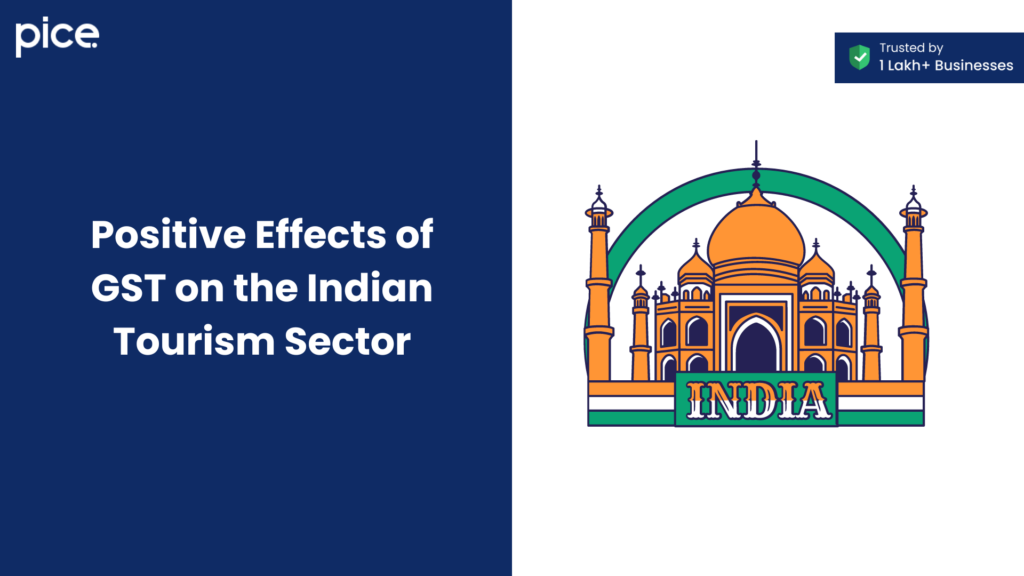Impact of GST on the Indian Tourism Sector
- 20 Sep 24
- 17 mins

Impact of GST on the Indian Tourism Sector
Key Takeaways
- GST has simplified the tax structure in the Indian tourism sector by replacing multiple taxes with a single, streamlined tax regime.
- The introduction of Input Tax Credit (ITC) under GST has reduced overall tax burdens for businesses, improving cost efficiency in the tourism sector.
- Elevated GST rates for luxury services have increased the cost of high-end tourism, affecting demand and market competitiveness.
- The GST regime has encouraged growth in domestic tourism by making budget travel and accommodations more affordable.
- Despite the benefits, the complexity of GST rates and increased compliance costs present ongoing challenges for the tourism industry.
The implementation of the Goods and Services Tax (GST) in India has brought about significant changes in various sectors, including the tourism industry. As a sector that relies heavily on both domestic and international clientele, the tourism industry has experienced a range of impacts due to the new tax regime.
Pre-GST Era: Hospitality and Tourism
Before the introduction of GST, the Indian tourism sector operated under a complex tax regime characterized by multiple taxes at different stages of the tourism value chain. The taxation process involved various indirect taxes such as service tax, luxury tax, and VAT, each imposed by different authorities at varying rates. The tax rates were inconsistent across states, creating a fragmented system that led to significant procedural steps and compliance costs for businesses in the hospitality industry.
Service providers in the tourism sector, including hotels, travel agencies, and restaurants, faced challenges due to the lack of a uniform tax structure. This often resulted in higher costs for customers as businesses had to account for multiple tax burdens in their pricing strategies. Additionally, the impact on tourism was felt in the form of operational inefficiencies, increased costs for compliance, and limited opportunities for claiming tax credits on inputs, leading to higher overall costs of operations.
The pre-GST regime also imposed a luxury tax on high-end services, such as luxury accommodations and upscale dining, further increasing the cost for consumers. This fragmented tax structure not only affected domestic tourism but also placed Indian tourism at a competitive disadvantage compared to Asian neighbors with more streamlined tax systems. The lack of parity in tax regimes across states and the overall complexity of tax calculations made it challenging for businesses to operate efficiently and for customers to find cost-effective travel options.
Hospitality and Tourism in the GST Era
The introduction of GST in July 2017 marked a significant shift in the Indian tax landscape, particularly for the tourism sector. GST replaced the multiple indirect taxes with a single tax regime, aiming to simplify the taxation process and create a more level playing field for businesses across the country. Under the GST regime, services provided by the tourism industry are now subject to a unified tax structure, with specific GST rates applicable to different services such as accommodation, food and beverages, and travel.
One of the key features of GST is the Input Tax Credit (ITC) mechanism, which allows businesses to claim credit for the GST paid on inputs used in providing taxable services. This has been a significant advantage for the tourism sector, as it helps reduce the overall tax burden and improve cost efficiency. For example, hotels can now claim ITC on expenses related to central heating, raw edibles, and other inputs, which helps in reducing the effective rate of GST on their services.
💡If you want to pay your GST with Credit Card, then download Pice Business Payment App. Pice is the one stop app for all paying all your business expenses.
However, the GST regime also brought about challenges, particularly in terms of increased compliance costs and the technological burden associated with filing regular GST returns. The tourism industry, which includes a large number of small and medium-sized enterprises (SMEs), has had to adapt to the new tax system by investing in technology and training to ensure compliance. Despite these challenges, the overall impact of GST on the tourism sector has been positive, with businesses benefiting from a more streamlined tax structure and improved revenue management.
Positive Effects of GST on the Indian Tourism Sector

Streamlined Tax System
One of the most significant positive impacts of GST on the tourism sector is the introduction of a streamlined tax system. By replacing multiple taxes with a single tax regime, GST has simplified the taxation process for businesses in the tourism industry. This has resulted in a reduction of compliance costs and operational difficulties that were prevalent in the pre-GST era. The uniform tax structure under GST has also eliminated the disparities in tax rates across different states, providing a more consistent and predictable environment for businesses to operate in.
The streamlined tax system under GST has also made it easier for businesses to manage their tax liabilities and claim Input Tax Credit (ITC). This has led to minimal cost reduction in the overall cost of operations, making it easier for businesses to offer competitive pricing to their customers. Moreover, the introduction of GST has reduced the incidence of double taxation, which was a common issue under the previous tax regime. This has helped in reducing the overall tax burden on businesses and improving their profitability.
Benefits of Input Tax Credit (ITC)
The availability of Input Tax Credit (ITC) under GST has been a game-changer for the tourism sector. ITC allows businesses to offset the GST paid on inputs against their output tax liability, resulting in significant cost savings. For example, a hotel can claim ITC on the GST paid for raw edibles, central heating, and other inputs used in providing accommodation services. This reduces the overall tax burden and allows businesses to offer more competitive pricing to their customers.
The utilization of ITC has also helped in improving the cash flow for businesses in the tourism sector. By claiming ITC on their input purchases, businesses can reduce their immediate tax liability, freeing up cash that can be reinvested in the business. This has been particularly beneficial for SMEs in the tourism sector, which often face cash flow challenges. The ITC mechanism has also encouraged businesses to maintain better records and ensure compliance with GST regulations, leading to improved tax management and reduced risk of penalties.
Growth in the Hospitality Sector
The implementation of GST has had a positive impact on the growth of the hospitality sector in India. The uniform tax structure under GST has reduced the cost of compliance and made it easier for businesses to expand their operations across different states. This has led to increased investment in the hospitality sector, with businesses opening new hotels, restaurants, and other tourism-related facilities across the country.
The growth in the hospitality sector has also been driven by the increased demand for domestic tourism, which has been encouraged by the GST regime. The availability of ITC has allowed businesses to offer more competitive pricing, making it more affordable for domestic tourists to travel and stay at hotels. This has led to an increase in the number of domestic tourists, driving growth in the hospitality sector and contributing to the overall development of the Indian economy.
Improved Market Competitiveness
GST has significantly improved the market competitiveness of the Indian tourism sector by creating a level playing field for businesses across the country. The elimination of multiple taxes and the introduction of a single tax regime have reduced the disparities in tax rates across different states, making it easier for businesses to compete on a national level. This has encouraged more businesses to enter the tourism sector, leading to increased competition and improved service quality for customers.
The improved market competitiveness has also been driven by the benefits of ITC, which have allowed businesses to reduce their overall tax burden and offer more competitive pricing. This has made the Indian tourism sector more attractive to both domestic and international tourists, leading to increased demand and growth in the sector. The improved competitiveness has also encouraged businesses to invest in new technologies and innovations, further driving growth and development in the tourism sector.
Encouragement of Domestic Tourism
One of the most significant positive impacts of GST on the tourism sector has been the encouragement of domestic tourism. The streamlined tax system and the availability of ITC have made it more affordable for domestic tourists to travel and stay at hotels. This has led to an increase in the number of domestic tourists, driving growth in the tourism sector and contributing to the overall development of the Indian economy.
The encouragement of domestic tourism has also been driven by the increased competitiveness of the Indian tourism sector under GST. The availability of ITC has allowed businesses to offer more competitive pricing, making it more attractive for domestic tourists to travel within the country. This has led to an increase in demand for travel and accommodation services, driving growth in the tourism sector and contributing to the overall development of the Indian economy.
Challenges of GST in the Indian Tourism Sector
Elevated Tax Rates for Luxury Services
Despite the benefits of GST, one of the key challenges faced by the tourism sector is the elevated tax rates for luxury services. Under GST, luxury services such as high-end hotel accommodations and upscale dining are subject to higher tax rates, often falling within the 28% tax slab. This is a significant increase compared to the pre-GST era, where luxury tax rates were lower and varied across states.
The elevated tax rates for luxury services have led to an increase in the cost of luxury accommodations and dining, making it more expensive for both domestic and international tourists. This has had a negative impact on the demand for luxury services, with many tourists opting for more affordable alternatives. The increased cost of luxury services has also affected the profitability of businesses in the luxury segment, leading to concerns about the long-term sustainability of the luxury tourism sector.
Complicated Tax Structure
Another challenge faced by the tourism sector under GST is the complexity of the tax structure. While GST has simplified the overall taxation process, the multiple tax rate slabs applicable to different services within the tourism sector have introduced new complexities. For example, different GST rates apply to accommodation services, food and beverage services, and travel services, leading to challenges in tax calculations and compliance.
The complicated tax structure has also led to increased compliance costs for businesses in the tourism sector. Businesses must invest in technology and training to ensure accurate tax calculations and timely filing of GST returns. This has been particularly challenging for SMEs in the tourism sector, which often lack the resources to manage the complexities of the GST regime. The increased compliance costs have also affected the profitability of businesses, particularly those operating in the lower-end segments of the tourism sector.
Operational Difficulties
The implementation of GST has also introduced operational difficulties for businesses in the tourism sector. The need to comply with the new tax regime has led to increased costs for compliance and technology, as businesses must invest in new systems and processes to ensure accurate tax calculations and timely filing of GST returns. This has been particularly challenging for SMEs in the tourism sector, which often lack the resources to manage the complexities of the GST regime.
The operational difficulties have also been compounded by the frequent changes in GST rates and regulations, which have made it difficult for businesses to plan and manage their operations effectively. The uncertainty surrounding GST compliance has led to increased operational costs and reduced profitability for businesses in the tourism sector. This has been particularly challenging for businesses operating in the lower-end segments of the tourism sector, which are more sensitive to changes in tax rates and regulations.
Effects on Pricing and Market Competitiveness
The GST regime has had a significant impact on the pricing strategies of businesses in the tourism sector. The introduction of GST has led to an increase in the overall cost of services, particularly in the luxury segment, where elevated tax rates have made services more expensive. This has affected the competitiveness of Indian tourism, particularly when compared to Asian counterparts with lower tax rates.
The impact on pricing has also been felt in the form of reduced demand for high-end services, as tourists opt for more affordable alternatives. This has affected the profitability of businesses in the luxury segment and raised concerns about the long-term sustainability of the luxury tourism sector. The increased cost of services has also led to concerns about the overall competitiveness of the Indian tourism sector, particularly in the context of attracting international tourists.
GST Rates in the Indian Tourism Sector
GST Rates for Accommodation Services
The GST rates for accommodation services in the Indian tourism sector vary depending on the tariff charged by the hotel. For rooms with a tariff of Rs. 1,000 or less per night, there is no GST applicable. For rooms with a tariff between Rs. 1,001 and Rs. 7,500 per night, a GST rate of 12% is applicable. Rooms with a tariff above Rs. 7,500 per night are subject to a GST rate of 18%. This tiered tax structure has introduced a degree of complexity in the pricing strategies of hotels, particularly those catering to both budget and luxury segments.
The GST rates for accommodation services have a direct impact on the cost of hotel accommodation, influencing the choices of domestic and international tourists. While the lower GST rates for budget accommodations have made it more affordable for domestic tourists, the higher rates for luxury accommodations have led to an increase in the overall cost of luxury stays. This has affected the demand for luxury accommodations, particularly among price-sensitive tourists.
GST Rates for Food and Beverage Services
The GST rates for food and beverage services in the tourism sector vary based on the type of establishment. For restaurants located within hotels with room tariffs of Rs. 7,500 or above, the GST rate is 18%. Standalone restaurants are subject to a GST rate of 5% without the benefit of Input Tax Credit (ITC). For outdoor catering services, the GST rate is set at 18%.
These GST rates have had a mixed impact on the food and beverage segment of the tourism sector. While the lower GST rate for standalone restaurants has made dining more affordable for domestic tourists, the lack of ITC has led to concerns about the overall cost efficiency of these establishments. On the other hand, the higher GST rate for restaurants within luxury hotels has increased the cost of dining, affecting the demand for high-end food and beverage services.
GST Rates for Travel and Tour Services
The GST rates for travel and tour services in the tourism sector also vary depending on the type of service provided. For air travel, the GST rate is 5% for economy class and 12% for business class. For tour operator services, the GST rate is set at 5% on the gross commission earned by the operator. These rates have a direct impact on the cost of travel and tour services, influencing the choices of domestic and international tourists.
The GST rates for travel and tour services have had a significant impact on the overall competitiveness of the Indian tourism sector. While the lower GST rates for economy air travel have made it more affordable for domestic tourists to travel within the country, the higher rates for business class and tour operator services have affected the demand for these services. This has raised concerns about the overall competitiveness of the Indian tourism sector, particularly in the context of attracting high-spending international tourists.
Effect of GST Rates on the Tourism Sector
The effect of GST rates on the tourism sector has been mixed, with both positive and negative impacts. While the streamlined tax system and the availability of ITC have improved cost efficiency and reduced the overall tax burden for businesses, the elevated tax rates for luxury services have introduced new challenges. The increased cost of services, particularly in the luxury segment, has affected the demand for high-end tourism services, raising concerns about the long-term sustainability of the luxury tourism sector.
The impact of GST rates on the tourism sector has also been felt in the form of reduced competitiveness, particularly when compared to Asian counterparts with lower tax rates. The increased cost of services has made it more challenging for the Indian tourism sector to attract international tourists, particularly in the high-end segment. This has raised concerns about the overall growth and development of the Indian tourism sector in the context of the global tourism industry.
 By
By 

















